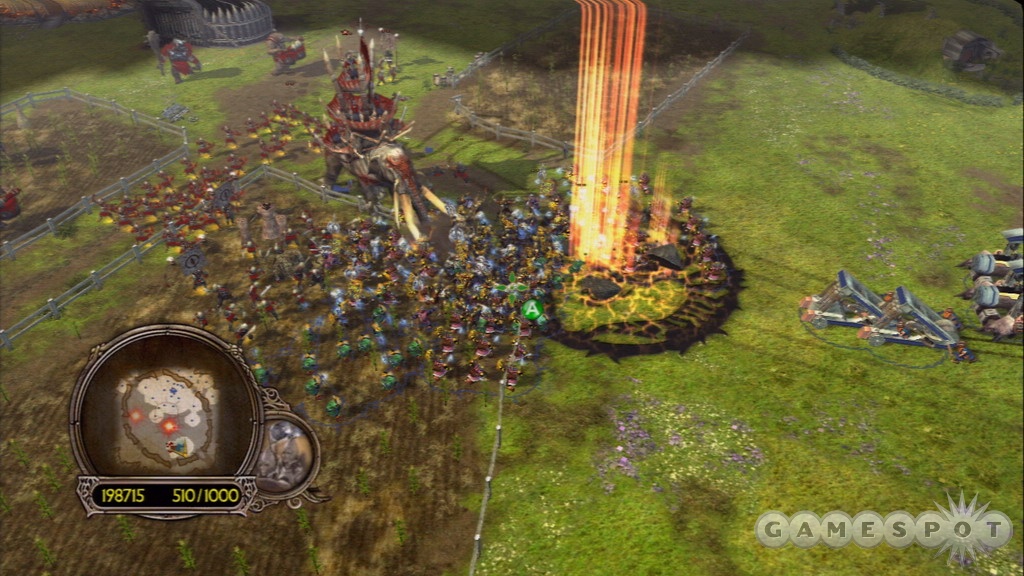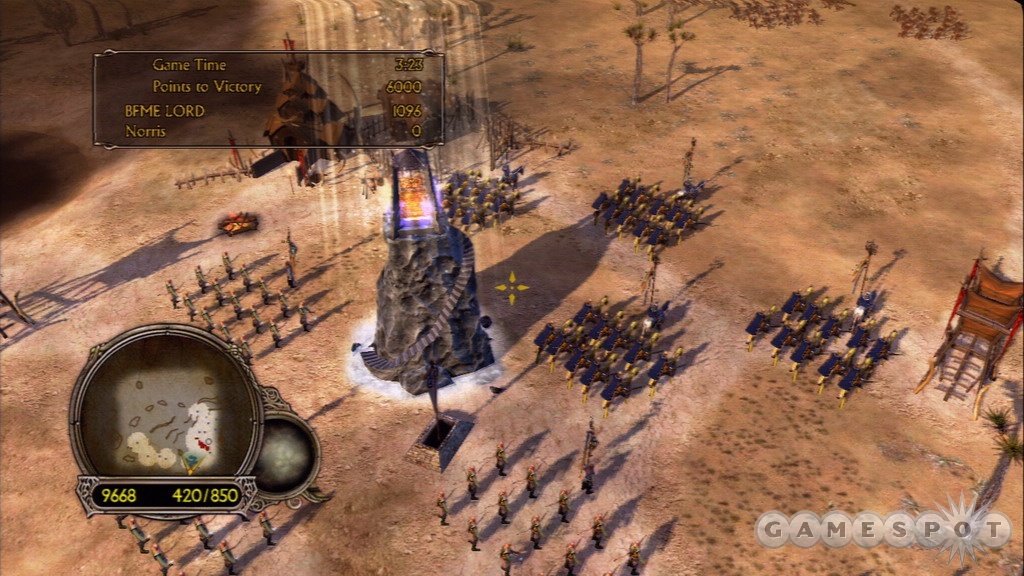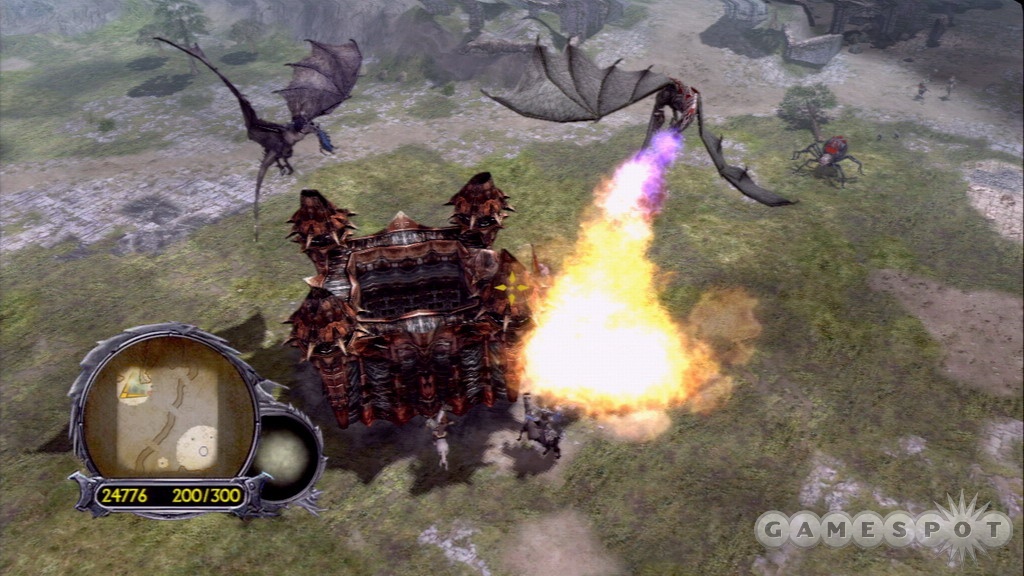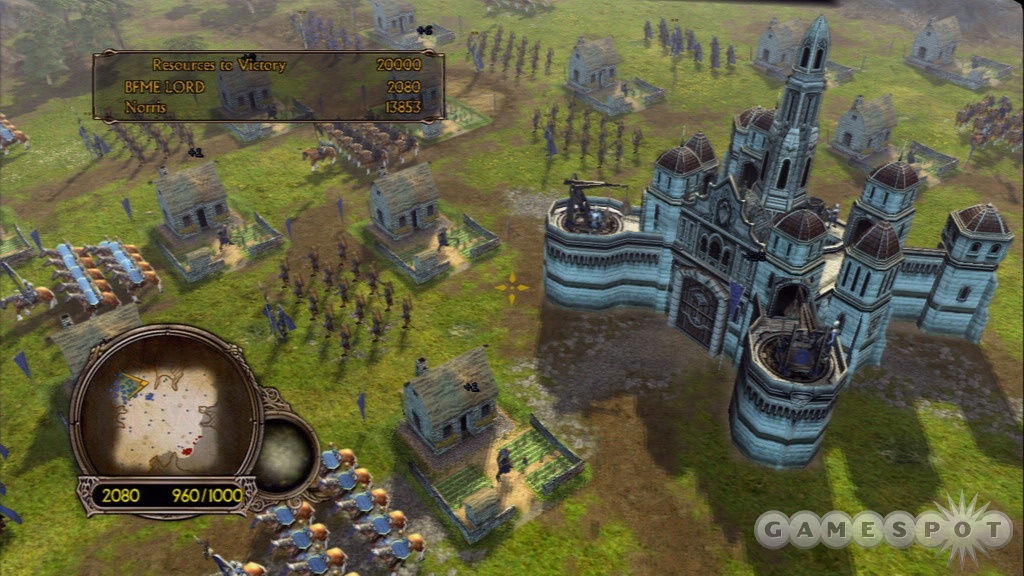The Lord of the Rings, The Battle for Middle-earth II Multiplayer Hands-On
We battle the designers at EA in online matches to get a feel for the many new multiplayer modes in this real-time strategy game for the Xbox 360.
Real-time strategy is the one major PC genre that still hasn't translated successfully to the consoles, thanks to the fact that these games seem designed more for the keyboard and mouse rather than the gamepad. However, when EA developed last year's The Lord of the Rings, The Battle for Middle-earth II for the PC, it also designed the game to work with a gamepad in mind. The result is the upcoming Xbox 360 version of the game, which is remarkably similar to the PC version in terms of content. The big difference, of course, is that EA spent a lot of time and effort translating the controls to work on a gamepad.

Of course, when you talk about real-time strategy, you have to talk about multiplayer, which is one of the most popular aspects of these games. It's one thing to crush the computer in single-player, but it's far more satisfying (and challenging) to go online and battle friends and strangers. EA hasn't neglected multiplayer in the Xbox 360 version of the game, especially since Xbox Live offers a much stronger foundation for multiplayer gameplay than anything found on the PC. To test this out, we battled some of the design team recently to see how the multiplayer game plays.
The Battle for Middle-earth II will ship with a fairly large multiplayer suite. All six of the game's factions are available, of course, and there are a considerable number of maps. However, where the Xbox 360 version really impresses is in the number of multiplayer modes. There are five in the game (compared to just two in the PC game), and they're geared to provide different gameplay experiences as well as multiplayer matches that can be finished in as little as 10 to 15 minutes. First, there's versus mode, which is equivalent to the traditional skirmish mode. Everyone starts on the map with a small base and must crush everyone else to be the last man standing. You'll do this by building up a huge economy and an equally huge army with which you'll wipe out all the other units.
Next up is the capture-the-flag mode, which features a signal fire in the middle of the map that must be captured and held for a set amount of time in order to win. Our experience showed this mode to be a desperate battle against the clock, since there can be an overall time limit to the game that keeps the pressure on all the players. For instance, you may spend the first 10 minutes trying to build up your resource base and army, but at a certain point you have no choice but to throw your forces into the fray to capture the signal fire because time has run out.

Of course, if there are multiple players contesting the center point, it comes down to a battle of attrition, as usually two players will battle for control of the tower, and just as one player wins, a third player arrives with a fresh new army and wipes out the survivors. This process can be repeated over and over again, so one tactic in capture the flag will be to attack someone else's base in order to cripple their war-making capacity, thus reducing their ability to influence events in the center of the map.
Then there's the capture-and-hold mode, which is somewhat similar to capture the flag, except that it features five capture points on the map, rather than one. The goal is to capture and hold as many points as possible in order to accumulate the most overall capture time. So, essentially capture and hold is the real-time strategy equivalent to the territories multiplayer mode in Halo 2. You'll have to decide how to divide your forces so you can capture and defend enough capture points on the map to win. You can expect yet another seesaw ride as players desperately attack and counterattack for these points.
Resource race is a mode that provides a twist to the familiar real-time strategy formula. In this mode, you again want to build up a base and a large army, though at the same time, you also want to conserve resources. And this is because the winner in resource race is the first player to accumulate, say, 5,000 resources (the number is adjustable). However, since everyone's resource status is displayed on the screen, you'll know if an enemy is close to reaching their mark.

The correct course of action when this happens is to launch an attack on the enemy's base, so they'll have to spend resources in order to defend their resource-gathering structures. There are all sorts of clever strategies that can come into play in this mode. For instance, if you're close to the victory limit, you can sell all your structures in order to cash them in. However, you must be careful, because if you fall short of the limit, you'll find yourself with a crippled economy at a late stage in the game.
Finally, there's hero versus hero, which doesn't bear a resemblance to any sort of traditional real-time strategy mode. There's no base construction or army-building. Instead, each player only has four hero characters, such as Gandalf, Aragorn, or the Witch King, and one bulked-up fortress, which is used as a respawn point. The goal in this mode is to level up your heroes by slaying the various monsters infesting the map, while at the same time destroying their lairs and recovering the gold therein. When you encounter another player's heroes, you can do battle, and if a hero is slain, you can use the gold to resurrect that fallen hero back at your fortress. However, while a hero is out of commission, his or her rank won't be counted in your score, which is the sum of your heroes' character level. The winner at the end of the match is the player with the highest score when time runs out.
We played through a number of battles, and we discovered that the controls are actually not so much of an issue as we thought they'd be. While the gamepad hardly seems like a substitute for the PC's keyboard and mouse, it actually doesn't take too long to get used to the controls in Battle for Middle-earth II. The control scheme is actually well thought out, and it feels intuitive after some practice. We feel that the gamepad offers more of a level playing field than the keyboard and mouse, and the main differentiator is going to be who the better strategist is, rather than who has the fastest reflexes. Even though we lost in our battles against the designers, it felt more like the reason we lost was that we didn't play aggressively enough to win or we weren't as familiar with the subtle game mechanics as they were. It didn't feel like our defeats were due to the control scheme or gamepad.

However, perhaps the biggest difference between the Xbox 360 version and the PC version is voice. Very few PC gamers use headsets in real-time strategy games, but voice chat is a foundation of Xbox Live, which means that with the Xbox 360 version you can chat at length with your fellow players. It also means you can easily form alliances of convenience if some other player is threatening to win the match, or you can dish out some trash talk if your dragon just crushed someone's army. If you're a PC real-time strategy fan, multiplayer tends to be a fairly dry affair, as you have to use text chat to communicate. Having voice makes the experience much more personable.
While all this still won't make a difference to diehard real-time strategy fans on the PC, there's definitely promise for real-time strategy on the console. The fact remains that there just aren't any kind of real-time strategy experiences to be found on the Xbox 360, let alone Xbox Live. The Battle for Middle-earth II may fill this niche quite nicely, and it will offer a multiplayer experience that's vastly different from the many first-person shooters and sports games that are currently popular on Xbox Live.
Got a news tip or want to contact us directly? Email news@gamespot.com
Join the conversation